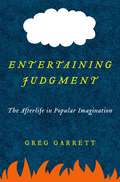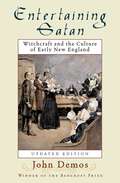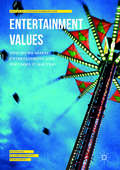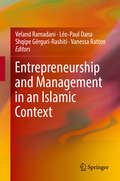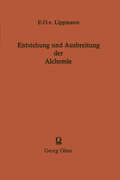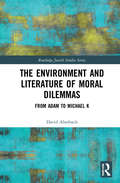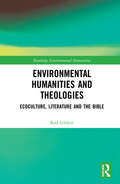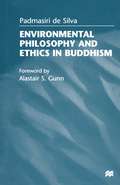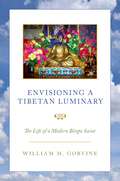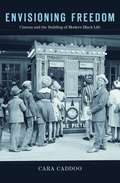- Table View
- List View
Entering the Twofold Mystery: On Christian Conversion
by Erik VardenErik Varden published The Shattering of Loneliness in 2018. Now, with the world in the throes of uncertainty and turbulence, he helps us interpret the signs of the times, convinced that the perennial experience of monks and nuns has much to teach us. The principles of monasticism have become attractive to many, awakened as we are to the importance of integrity, the pursuit of peace, asceticism as a path to freedom, hospitality and contemplative seeing. After a deeply personal introduction, Varden invites us to consider what makes a monk. He then takes us on a pilgrimage through the Church's year, drawing on Scripture, tradition and literary and religious figures of our time. Varden lets the reader discover the generous breadth and depth of a monk's outlook on life. In so doing he provides inspiration, enjoyment and enlightenment in equal measure.
Entertaining Judgment: The Afterlife in Popular Imagination
by Greg GarrettNowadays references to the afterlife-angels strumming harps, demons brandishing pitchforks, God enthroned on heavenly clouds-are more often encountered in New Yorker cartoons than in serious Christian theological reflection. Speculation about death and its sequel seems to embarrass many theologians; however, as Greg Garrett shows in Entertaining Judgment, popular culture in the U.S. has found rich ground for creative expression in the search for answers to the question: What lies in store for us after we die? The lyrics of Madonna, Los Lonely Boys, and Sean Combs; the plotlines of TV's Lost, South Park, and The Walking Dead; the implied theology in films such as The Dark Knight, Ghost, and Field of Dreams; the heavenly half-light of Thomas Kinkade's popular paintings; the ghosts, shades, and after-life way-stations in Harry Potter; and the characters, situations, and locations in the Hunger Games saga all speak to our hopes and fears about what comes next. In a rich survey of literature and popular media, Garrett compares cultural accounts of death and the afterlife with those found in scripture. Denizens of the imagined afterlife, whether in heaven, hell, on earth, or in purgatory, speak to what awaits us, at once shaping and reflecting our deeply held-if often somewhat nebulous-beliefs. They show us what rewards and punishments we might expect, offer us divine assistance, and even diabolically attack us. Ultimately, we are drawn to these stories of heaven, hell, and purgatory--and to stories about death and the undead--not only because they entertain us, but because they help us to create meaning and to learn about ourselves, our world, and, perhaps, the next world. Garrett's deft analysis sheds new light on what popular culture can tell us about the startlingly sharp divide between what modern people profess to believe and what they truly hope and expect to find after death--and how they use those stories to help them understand this life.
Entertaining Judgment: The Afterlife in Popular Imagination
by Greg GarrettNowadays references to the afterlife-angels strumming harps, demons brandishing pitchforks, God enthroned on heavenly clouds-are more often encountered in New Yorker cartoons than in serious Christian theological reflection. Speculation about death and its sequel seems to embarrass many theologians; however, as Greg Garrett shows in Entertaining Judgment, popular culture in the U.S. has found rich ground for creative expression in the search for answers to the question: What lies in store for us after we die? The lyrics of Madonna, Los Lonely Boys, and Sean Combs; the plotlines of TV's Lost, South Park, and The Walking Dead; the implied theology in films such as The Dark Knight, Ghost, and Field of Dreams; the heavenly half-light of Thomas Kinkade's popular paintings; the ghosts, shades, and after-life way-stations in Harry Potter; and the characters, situations, and locations in the Hunger Games saga all speak to our hopes and fears about what comes next. In a rich survey of literature and popular media, Garrett compares cultural accounts of death and the afterlife with those found in scripture. Denizens of the imagined afterlife, whether in heaven, hell, on earth, or in purgatory, speak to what awaits us, at once shaping and reflecting our deeply held-if often somewhat nebulous-beliefs. They show us what rewards and punishments we might expect, offer us divine assistance, and even diabolically attack us. Ultimately, we are drawn to these stories of heaven, hell, and purgatory--and to stories about death and the undead--not only because they entertain us, but because they help us to create meaning and to learn about ourselves, our world, and, perhaps, the next world. Garrett's deft analysis sheds new light on what popular culture can tell us about the startlingly sharp divide between what modern people profess to believe and what they truly hope and expect to find after death--and how they use those stories to help them understand this life.
Entertaining Satan: Witchcraft and the Culture of Early New England
by John Putnam DemosIn the first edition of the Bancroft Prize-winning Entertaining Satan, John Putnam Demos presented an entirely new perspective on American witchcraft. By investigating the surviving historical documents of over a hundred actual witchcraft cases, he vividly recreated the world of New England during the witchcraft trials and brought to light fascinating information on the role of witchcraft in early American culture. Now Demos has revisited his original work and updated it to illustrate why these early Americans' strange views on witchcraft still matter to us today. He provides a new preface that puts forth a broader overview of witchcraft and looks at its place around the world--from ancient times right up to the present.
Entertaining Satan: Witchcraft and the Culture of Early New England
by John Putnam DemosIn the first edition of the Bancroft Prize-winning Entertaining Satan, John Putnam Demos presented an entirely new perspective on American witchcraft. By investigating the surviving historical documents of over a hundred actual witchcraft cases, he vividly recreated the world of New England during the witchcraft trials and brought to light fascinating information on the role of witchcraft in early American culture. Now Demos has revisited his original work and updated it to illustrate why these early Americans' strange views on witchcraft still matter to us today. He provides a new preface that puts forth a broader overview of witchcraft and looks at its place around the world--from ancient times right up to the present.
Entertainment Values: How do we Assess Entertainment and Why does it Matter? (Palgrave Entertainment Industries)
by Stephen HarringtonThis collection brings together the work of a range of scholars from around the world with different perspectives on one simple question: How can we assess the value of various entertainment products and forms?Entertainment is everywhere. The industries that produce it earn billions of dollars each year and employ hundreds of thousands of people. Its pervasiveness means almost everyone has something to say about entertainment, too, whether it be our opinion on the latest Hollywood blockbuster, a new celebrity couple, or our concerns over its place in the world of politics. And yet, in spite of its significance, entertainment has too-often been dismissed with surprising ease within the academy as a ‘mindless’, ‘lowbrow’ – even ‘dangerous’ – form of culture, and therefore unworthy of serious appraisal (let alone praise).Entertainment Values, challenges this assumption, offering a better understanding of what entertainment is, why we should take it seriously, as well as helping us to appreciate the significant and complex impact it has on our culture.
The Enthusiast: Anatomy of the Fanatic in Seventeenth-Century British Culture
by William Cook MillerThe Enthusiast tells the story of a character type that was developed in early modern Britain to discredit radical prophets during an era that witnessed the dismantling of the Church of England's traditional means for punishing heresy. As William Cook Miller shows, the caricature of fanaticism here called the Enthusiast began as propaganda against religious dissenters, especially working-class upstarts, but was adopted by a range of writers as a literary vehicle for exploring profound problems of spirit, soul, and body and as a persona for the ironic expression of their own prophetic illuminations. Taking shape through the public and private writings of some of the most insightful authors of seventeenth-century Britain—Henry More, John Locke, the Third Earl of Shaftesbury, Mary Astell, and Jonathan Swift, among others—the Enthusiast appeared in various guises and literary modes. By attending to this literary being and its animators, The Enthusiast establishes the figure of the fanatic as a bridge between the Reformation and the Enlightenment, showing how an incipient secular modernity was informed by not the rejection of religion but the transformation of the prophet into something sparkling, witty, ironic, and new.
Enthymemes in the Letters of Paul: Enthymemes In The Letters Of Paul (The Library of New Testament Studies #303)
by Marc DebanneThis investigation looks at Paul's argumentation with special attention paid to enthymemes. Enthymemes can be defined as a three part deductive argumentation with an unstated assumption. Enthymemes constitute an important part of Paul's argumentation which until now has been relatively unexploited. Pauline studies continues today to grapple with the question of the core of Paul's thought and the investigation of the apostle's social world is gaining interest among scholars. This study of the manner in which Paul constructs enthymemes gives us insight into his thought world and would be a valuable text for scholars and librarians.
Entrepreneurs of Identity: The Islamic State’s Symbolic Repertoire (Integration and Conflict Studies #25)
by Christoph GüntherDescribing the Islamic State’s ideologues as ‘entrepreneurs of identity’, this book explores how the group defined categories of social identity and used these categories as tools of communicative and cognitive structuring. Based on a wide dossier of original texts, speeches, images, and videos, the book examines how these ideologues have built a symbolic repertoire around the black flag as well as ideas and social practices such as the dictum to command good and forbid wrong, the supervision of public behaviour, and the oath of allegiance to the Caliph.
Entrepreneurship and Management in an Islamic Context
by Veland Ramadani Léo-Paul Dana Shqipe Gërguri-Rashiti Vanessa RattenThe aim of this volume is to explore entrepreneurship and business from the perspective of Islamic principles, which are usually based on collaboration, teamwork, generosity and altruism. The contributions deal with the confluence of Islamic Principles with entrepreneurial and business ownership characteristics; resource use by entrepreneurs; means of entrepreneurial success, and ethics and social responsibility.
Entstehung und Ausbreitung der Alchemie: Ein Beitrag zur Kulturgeschichte
by Edmund O. LippmannDieser Buchtitel ist Teil des Digitalisierungsprojekts Springer Book Archives mit Publikationen, die seit den Anfängen des Verlags von 1842 erschienen sind. Der Verlag stellt mit diesem Archiv Quellen für die historische wie auch die disziplingeschichtliche Forschung zur Verfügung, die jeweils im historischen Kontext betrachtet werden müssen. Dieser Titel erschien in der Zeit vor 1945 und wird daher in seiner zeittypischen politisch-ideologischen Ausrichtung vom Verlag nicht beworben.
»Entwicklung« als Paradigma: Reflexionen zu einer nachhaltigen internationalen Zusammenarbeit (Global Studies)
by Patrick Becker Knut V. M. WormstädtMit der Moderne hat das Versprechen Einzug gehalten, dass sich die Probleme der Menschheit durch technischen, medizinischen und gesellschaftlichen Fortschritt lösen ließen. Darauf basiert das im Westen bis vor Kurzem nahezu unwidersprochene Entwicklungsparadigma. Inzwischen befördern ökologische Probleme und ökonomische Ungleichheiten Kritik, die etwa in der Fridays for Future-Bewegung Ausdruck findet. Die Beiträger*innen hinterfragen das Fortschrittsparadigma, indem sie im interdisziplinären und international-kultursensiblen Diskurs nach einem zeitgemäßen Verständnis von Entwicklungszusammenarbeit fragen und dazu auch Alternativen zum vorherrschenden westlichen Modell in den Blick nehmen.
The Environment and Literature of Moral Dilemmas: From Adam to Michael K (Routledge Jewish Studies Series)
by David AberbachExploring the literature of environmental moral dilemmas from the Hebrew Bible to modern times, this book argues the necessity of cross-disciplinary approaches to environmental studies, as a subject affecting everyone, in every aspect of life. Moral dilemmas are central in the literary genre of protest against the effects of industry, particularly in Romantic literature and ‘Condition of England’ novels. Writers from the time of the Industrial Revolution to the present—including William Blake, Elizabeth Gaskell, Charles Dickens, Émile Zola, Henrik Ibsen, Anton Chekhov, T.S. Eliot, John Steinbeck, George Orwell, and J.M. Coetzee—follow the Bible in seeing environmental problems in moral terms, as a consequence of human agency. The issues raised by these and other writers—including damage to the environment and its effects on health and quality of life, particularly on the poor; economic conflicts of interest; water and air pollution, deforestation, and the environmental effects of war—are fundamentally the same today, making their works a continual source of interest and insight. Sketching a brief literary history on the impact of human behavior on the environment, this volume will be of interest to readers researching environmental studies, literary studies, religious studies and international development, as well as a useful resource to scientists and readers of the Arts.
The Environment and Literature of Moral Dilemmas: From Adam to Michael K (Routledge Jewish Studies Series)
by David AberbachExploring the literature of environmental moral dilemmas from the Hebrew Bible to modern times, this book argues the necessity of cross-disciplinary approaches to environmental studies, as a subject affecting everyone, in every aspect of life. Moral dilemmas are central in the literary genre of protest against the effects of industry, particularly in Romantic literature and ‘Condition of England’ novels. Writers from the time of the Industrial Revolution to the present—including William Blake, Elizabeth Gaskell, Charles Dickens, Émile Zola, Henrik Ibsen, Anton Chekhov, T.S. Eliot, John Steinbeck, George Orwell, and J.M. Coetzee—follow the Bible in seeing environmental problems in moral terms, as a consequence of human agency. The issues raised by these and other writers—including damage to the environment and its effects on health and quality of life, particularly on the poor; economic conflicts of interest; water and air pollution, deforestation, and the environmental effects of war—are fundamentally the same today, making their works a continual source of interest and insight. Sketching a brief literary history on the impact of human behavior on the environment, this volume will be of interest to readers researching environmental studies, literary studies, religious studies and international development, as well as a useful resource to scientists and readers of the Arts.
Environmental Guilt and Shame: Signals of Individual and Collective Responsibility and the Need for Ritual Responses
by Sarah E. FredericksBloggers confessing that they waste food, non-governmental organizations naming corporations selling unsustainably harvested seafood, and veterans apologizing to Native Americans at the Standing Rock Sioux Reservation for environmental and social devastation caused by the United States government all signal the existence of action-oriented guilt and identity-oriented shame about participation in environmental degradation. Environmental Guilt and Shame demonstrates that these moral emotions are common among environmentally friendly segments of the United States but have received little attention from environmental ethicists though they can catalyze or hinder environmental action. Concern about environmental guilt and shame among “everyday environmentalists” reveals the practical, emotional, ethical, and existential issues raised by environmental guilt and shame and ethical insights about guilt, shame, responsibility, agency, and identity. A typology of guilt and shame enables the development and evaluation of these ethical insights. Environmental Guilt and Shame makes three major claims: first, individuals and collectives, including the diffuse collectives that cause climate change, can have identity, agency, and responsibility and thus guilt and shame. Second, some agents, including collectives, should feel guilt and/or shame for environmental degradation if they hold environmental values and think that their actions shape and reveal their identity. Third, a number of conditions are required to conceptually, existentially, and practically deal with guilt and shame's effects on agents. These conditions can be developed and maintained through rituals. Existing rituals need more development to fully deal with individual and collective guilt and shame as well as the anthropogenic environmental degradation that may spark them.
Environmental Guilt and Shame: Signals of Individual and Collective Responsibility and the Need for Ritual Responses
by Sarah E. FredericksBloggers confessing that they waste food, non-governmental organizations naming corporations selling unsustainably harvested seafood, and veterans apologizing to Native Americans at the Standing Rock Sioux Reservation for environmental and social devastation caused by the United States government all signal the existence of action-oriented guilt and identity-oriented shame about participation in environmental degradation. Environmental Guilt and Shame demonstrates that these moral emotions are common among environmentally friendly segments of the United States but have received little attention from environmental ethicists though they can catalyze or hinder environmental action. Concern about environmental guilt and shame among “everyday environmentalists” reveals the practical, emotional, ethical, and existential issues raised by environmental guilt and shame and ethical insights about guilt, shame, responsibility, agency, and identity. A typology of guilt and shame enables the development and evaluation of these ethical insights. Environmental Guilt and Shame makes three major claims: first, individuals and collectives, including the diffuse collectives that cause climate change, can have identity, agency, and responsibility and thus guilt and shame. Second, some agents, including collectives, should feel guilt and/or shame for environmental degradation if they hold environmental values and think that their actions shape and reveal their identity. Third, a number of conditions are required to conceptually, existentially, and practically deal with guilt and shame's effects on agents. These conditions can be developed and maintained through rituals. Existing rituals need more development to fully deal with individual and collective guilt and shame as well as the anthropogenic environmental degradation that may spark them.
Environmental Humanities and the Uncanny: Ecoculture, Literature and Religion (Routledge Explorations in Environmental Studies)
by Rod GiblettSigmund Freud’s essay 'The Uncanny' is celebrating a century since publication. It is arguably his greatest and most fruitful contribution to the study of culture and the environment. Environmental Humanities and the Uncanny brings into the open neglected aspects of the uncanny in this famous essay in its centenary year and in the work of those before and after him, such as Friedrich Schelling, Walter Benjamin, E. T. A. Hoffmann and Bram Stoker. This book does so by focussing on religion, especially at a time and for a world in which some sectors of the monotheisms are in aggressive, and sometimes violent, contention against those of other monotheisms, and even against other sectors within their own monotheism. The chapter on Schelling’s uncanny argues that monotheisms come out of polytheism and makes the plea for polytheism central to the whole book. It enables rethinking the relationships between mythology and monotheistic and polytheistic religions in a culturally and politically liberatory and progressive way. Succeeding chapters consider the uncanny cyborg, the uncanny and the fictional, and the uncanny and the Commonwealth, concluding with a chapter on Taoism as a polytheistic religion. Building on the author’s previous work in Environmental Humanities and Theologies in bringing together theories of religion and the environment, this book will be of great interest to students and scholars of the environmental humanities, ecocultural studies and religion.
Environmental Humanities and the Uncanny: Ecoculture, Literature and Religion (Routledge Explorations in Environmental Studies)
by Rod GiblettSigmund Freud’s essay 'The Uncanny' is celebrating a century since publication. It is arguably his greatest and most fruitful contribution to the study of culture and the environment. Environmental Humanities and the Uncanny brings into the open neglected aspects of the uncanny in this famous essay in its centenary year and in the work of those before and after him, such as Friedrich Schelling, Walter Benjamin, E. T. A. Hoffmann and Bram Stoker. This book does so by focussing on religion, especially at a time and for a world in which some sectors of the monotheisms are in aggressive, and sometimes violent, contention against those of other monotheisms, and even against other sectors within their own monotheism. The chapter on Schelling’s uncanny argues that monotheisms come out of polytheism and makes the plea for polytheism central to the whole book. It enables rethinking the relationships between mythology and monotheistic and polytheistic religions in a culturally and politically liberatory and progressive way. Succeeding chapters consider the uncanny cyborg, the uncanny and the fictional, and the uncanny and the Commonwealth, concluding with a chapter on Taoism as a polytheistic religion. Building on the author’s previous work in Environmental Humanities and Theologies in bringing together theories of religion and the environment, this book will be of great interest to students and scholars of the environmental humanities, ecocultural studies and religion.
Environmental Humanities and Theologies: Ecoculture, Literature and the Bible (Routledge Environmental Humanities)
by Rod GiblettMany ways of thinking about and living with ‘the environment’ have their roots in the Bible and the Christian cultural tradition. Environmental Humanities and Theologies shows that some of these ways are problematic. It also provides alternative ways that value both materiality and spirituality. Beginning with an environmentally friendly reading of the biblical story of creation, Environmental Humanities and Theologies goes on to discuss in succeeding chapters the environmental theology of wetlands, dragons and watery monsters (including crocodiles and alligators) in the Bible and literature. It then gives a critical reading of the environmental theology of the biblical book of Psalms. Theological concepts are found in the works of English writers of detective and devotional stories and novels, American nature writers and European Jewish writers (as succeeding chapters show). Environmental Humanities and Theologies concludes with an appreciation for Australian Aboriginal spirituality in the swamp serpent. It argues for the sacrality of marsh monsters and swamp serpents as figures of reverence and respect for living bio- and psycho-symbiotic livelihoods in bioregions of the living earth in the Symbiocene. This is the hoped-for age superseding the Anthropocene. Environmental Humanities and Theologies is aimed at those who have little or no knowledge of how theology underlies much thinking and writing about ‘the environment’ and who are looking for ways of thinking about, being and living with the earth that respect and value both spirituality and materiality. It is a new text nurturing sacrality for the Symbiocene.
Environmental Humanities and Theologies: Ecoculture, Literature and the Bible (Routledge Environmental Humanities)
by Rod GiblettMany ways of thinking about and living with ‘the environment’ have their roots in the Bible and the Christian cultural tradition. Environmental Humanities and Theologies shows that some of these ways are problematic. It also provides alternative ways that value both materiality and spirituality. Beginning with an environmentally friendly reading of the biblical story of creation, Environmental Humanities and Theologies goes on to discuss in succeeding chapters the environmental theology of wetlands, dragons and watery monsters (including crocodiles and alligators) in the Bible and literature. It then gives a critical reading of the environmental theology of the biblical book of Psalms. Theological concepts are found in the works of English writers of detective and devotional stories and novels, American nature writers and European Jewish writers (as succeeding chapters show). Environmental Humanities and Theologies concludes with an appreciation for Australian Aboriginal spirituality in the swamp serpent. It argues for the sacrality of marsh monsters and swamp serpents as figures of reverence and respect for living bio- and psycho-symbiotic livelihoods in bioregions of the living earth in the Symbiocene. This is the hoped-for age superseding the Anthropocene. Environmental Humanities and Theologies is aimed at those who have little or no knowledge of how theology underlies much thinking and writing about ‘the environment’ and who are looking for ways of thinking about, being and living with the earth that respect and value both spirituality and materiality. It is a new text nurturing sacrality for the Symbiocene.
Environmental Humanities in Folktales: Theory and Practice
by P. Mary PorselviThis work throws light on the areas of space and time, nature and culture, spirit and matter in the folktales that nurture systemic thinking. It identifies and explores motifs and patterns in select folktales that promote interconnectedness, interdependence, holism, synthesis, and circular pattern of life and examines the ecological relevance of folktales in fostering a systematic view of life. The volume discusses why it is important to critically analyze alternative worldviews in order to find holistic solutions to contemporary global ecological issues. It sheds light upon Ecofemiotics as a discipline, a portmanteau of Ecofeminist Semiotics, and through a re-reading of folktales, it puts forward an innovative folktale typology which connects women with environment. The book discusses an ecofemiotics cyclical praxis at three levels, • Promoting theory to practice through the analysis of folktales as Gaia Care Narratives using the Ecofemiotic framework. • Enabling practice to theory, through a classroom experiment, observation, and inference. • Envisioning theory to practice, through the identification of Gaia Care Principles and its multidisciplinary hands-on scope and function to create avenues towards ecological balance and sustainable living. Inspired by the hearts that tell stories of love, care, nurture, and the Earth, this nuanced work will be of interest to students and researchers of literature and literary theory, sociology, social anthropology, gender studies and women’s studies, feminism, development studies, environment, and folklore studies.
Environmental Humanities in Folktales: Theory and Practice
by P. Mary PorselviThis work throws light on the areas of space and time, nature and culture, spirit and matter in the folktales that nurture systemic thinking. It identifies and explores motifs and patterns in select folktales that promote interconnectedness, interdependence, holism, synthesis, and circular pattern of life and examines the ecological relevance of folktales in fostering a systematic view of life. The volume discusses why it is important to critically analyze alternative worldviews in order to find holistic solutions to contemporary global ecological issues. It sheds light upon Ecofemiotics as a discipline, a portmanteau of Ecofeminist Semiotics, and through a re-reading of folktales, it puts forward an innovative folktale typology which connects women with environment. The book discusses an ecofemiotics cyclical praxis at three levels, • Promoting theory to practice through the analysis of folktales as Gaia Care Narratives using the Ecofemiotic framework. • Enabling practice to theory, through a classroom experiment, observation, and inference. • Envisioning theory to practice, through the identification of Gaia Care Principles and its multidisciplinary hands-on scope and function to create avenues towards ecological balance and sustainable living. Inspired by the hearts that tell stories of love, care, nurture, and the Earth, this nuanced work will be of interest to students and researchers of literature and literary theory, sociology, social anthropology, gender studies and women’s studies, feminism, development studies, environment, and folklore studies.
Environmental Philosophy and Ethics in Buddhism
by Padmasiri De SilvaThis work introduces the reader to the central issues and theories in western environmental ethics, and against this background develops a Buddhist environmental philosophy and code of ethics. It contains a lucid exposition of Buddhist environmentalism, its ethics, economics and Buddhist perspectives for environmental education. The work is focused on a diagnosis of the contemporary environmental crisis and a Buddhist contribution to positive solutions. Replete with stories and illustrations from original Buddhist sources, it is both informative and engaging.
Envisioning a Tibetan Luminary: The Life of a Modern Bönpo Saint
by William M. GorvineEnvisioning a Tibetan Luminary examines the religious biography of Shardza Tashi Gyaltsen (1859-1934), the most significant modern figure representing the Tibetan Bön religion-a vital minority tradition that is underrepresented in Tibetan studies. The work is based on fieldwork conducted in eastern Tibet and in the Bön exile community in India, where traditional Tibetan scholars collaborated closely on the project. Utilizing close readings of two versions of Shardza's life-story, along with oral history collected in Bön communities, this book presents and interprets the biographical image of this major figure, culminating with an English translation of his life story. William M. Gorvine argues that the disciple-biographer's literary portrait not only enacts and shapes religious ideals to foster faith among its readership, but also attempts to quell tensions that had developed among his original audience. Among the Bön community today, Shardza Tashi Gyaltsen has come to be unequivocally revered for an impressive textual legacy and a saintly death. During his lifetime, however, he faced prominent critics within his own lineage who went so far as to issue polemical attacks against him. As Gorvine shows, the biographical texts that inform us about Shardza's life are best understood when read on multiple registers, with attention given to the ways in which the religious ideals on display reflect the broader literary, cultural, and historical contexts within which they were envisioned and articulated.
Envisioning Freedom: Cinema and the Building of Modern Black Life
by Cara CaddooIn Cara Caddoo’s perspective-changing study, African Americans emerge as pioneers of cinema from the 1890s to 1920s. But as it gained popularity, black cinema also became controversial. Black leaders demanded self-representation and an end to cinematic mischaracterizations which, they charged, violated the civil rights of African Americans.

